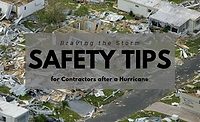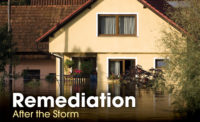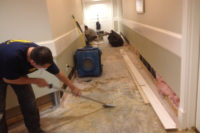After the Storm: Probiotic Cleaners and Post-Hurricane Remediation

The 2017 Atlantic hurricane season was remarkably destructive, with Hurricanes Harvey, Irma and Maria significantly impacting parts of Texas, Florida and the Caribbean. More than a decade earlier, Hurricanes Katrina and Rita wreaked similar havoc on the city of New Orleans, with the Centers for Disease Control and Prevention estimating that 46 percent of homes within city limits suffered some mold contamination. With the 2018 season in full swing, this is a timely moment to ponder new ways of improving the lasting effectiveness of remediation efforts for residences and business that have been contaminated by mold and other substances following such storms.
Although the remediation protocols currently used to eliminate mold are likely to remain vital in the wake of hurricanes, floods and other natural disasters, it is still worth asking: “What happens next?” The reason for this is simple: Even when an indoor environment has been cleared of mold, there is an ever-present risk of its return. A novel application of a well-known class of microbes — known as probiotics — has a great deal of potential value in helping ensure that a property can remain protected from mold following remediation. How and why can probiotics play a helpful role in this regard?
Keeping Mold at Bay Today and Tomorrow
Whether or not you have been involved in mold remediation projects in hurricane zones, the specific challenges of this type of job are obvious. Unlike projects involving remediation of a single room or office, it is often the case that an entire structure — or a substantial part of it — has been submerged by rising waters for a significant period of time. When the waters finally recede and the decision has been made to salvage the structure rather than demolish it, the magnitude of the job can appear daunting, especially if the amount of mold is extensive. Adding to the challenge is the fact that many hurricane-prone structures are located in humid climates — and high humidity is a natural habitat for mold growth.
The time-tested strategy for addressing mold infestations — involving the use of strong chemicals such as chlorine — works well. But this very solution introduces a drawback. Specifically, the use of these chemicals results in the elimination not only of the mold but also other forms of microbes in the local environment that are actually beneficial to the residents and workers who occupy it. By wiping these “good” bacteria out as well, an imbalance is created that may have an unintended impact.

An Inspiration from Antibiotics
This type of imbalance can be compared to what happens in the human body when antibiotics are used to fight infections. Although antibiotics are vital to eliminating bacterial infections, they can foster antibiotic resistance and upset the delicate balance of microbes in our gut that keeps us healthy over the long term. This imbalance, in turn, helps explain the rising popularity of probiotics as supplements — they work to restore the balance of microflora within our bodies.
As with our bodies, so it is with our living spaces. The inspiration for harnessing probiotics as a novel class of purification system has come with the realization that the environments in which we spend time can affect our health, just as the substances that we put inside our bodies do. Replenishing our living environments with beneficial and necessary microbes is as important as replenishing ourselves, and can ensure that the benefits of mold remediation are long-lasting.
Completing the Mold Remediation Cycle
It is important to stress that probiotics can not in themselves solve the mold problem in these spaces; instead, they can help prevent the recurrence of mold once the initial remediation work has been completed. It is an example of “completing the cycle” rather than doing anything permanent on their own.
So how can probiotics be introduced into a home or business, once the mold remediation process has been completed? The first step involves fogging the indoor space with a relatively large amount of probiotic vapor, perhaps one to two liters. The rationale for this initial step is twofold: it can help eliminate any mold-related odors that remain in the air following traditional remediation activities, and it can also provide a “microbial boost” that represents the first step toward rebalancing the levels of microbes in the immediate vicinity.

Following this, commercially available devices designed to disperse probiotics can be set up within the home or office. Installation of these devices is typically very simple, requiring no more than 10 minutes and no special equipment. If the space includes an air duct, a device can be connected to the wall next to the air handler with a hose connected to the duct. In this manner, the air flow ensures that the probiotics travel to all areas within the space.
The probiotics themselves do not remain in the air, however. Instead, they settle onto every surface within the home or office and begin to colonize it. In this way, they effectively create a “zone of inhibition” that prevents mold as well as allergens and pathogens from overgrowing in these same areas. Depending on the size of the indoor space, one or more individual devices can be set up to dispense probiotics. These devices operate around the clock, dispensing a small quantity of probiotics every hour for approximately one minute.
In light of its potential for extending the effectiveness of mold remediation in the wake of a hurricane, restoration and remediation companies might wish to explore the power of probiotics. Conceivably, mold remediation companies’ probiotics systems could be integrated into the warranties these companies offer as a value-add, to help guarantee that the mold that they have initially removed will not return.

While possibly new to many companies that have long been involved in mold remediation activities located in hurricane zones, environmental probiotics have an important role to play in this area. They deserve closer examination by those professionals whose clients expect the mold that has invaded their properties to be eliminated—not just today but tomorrow as well.
Looking for a reprint of this article?
From high-res PDFs to custom plaques, order your copy today!





